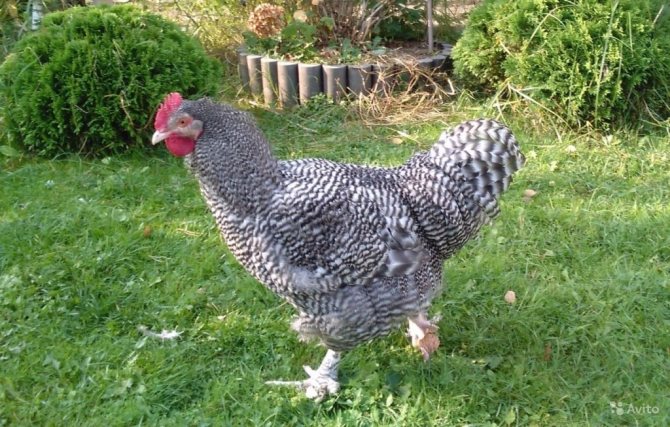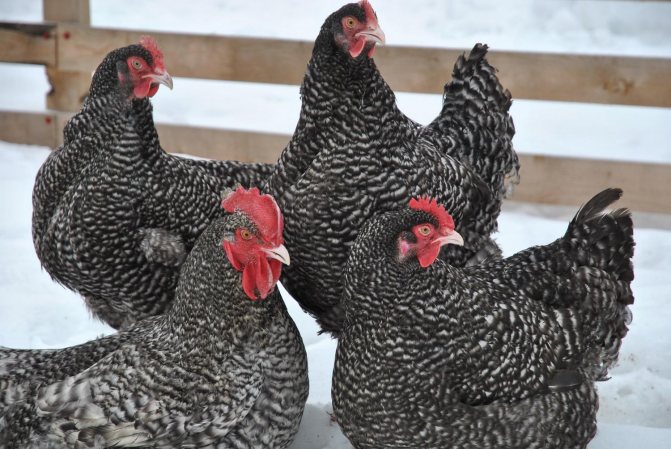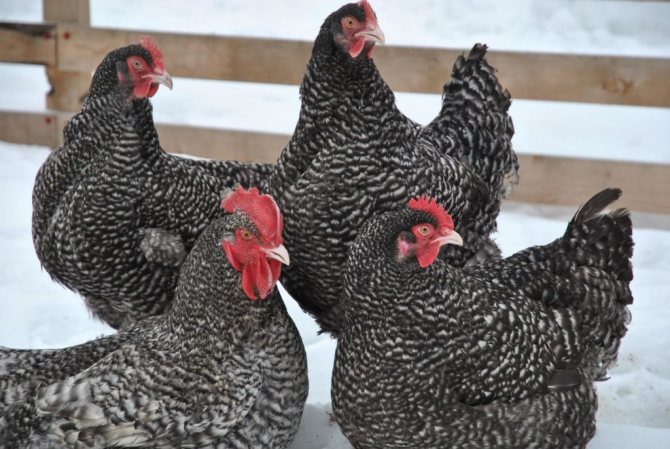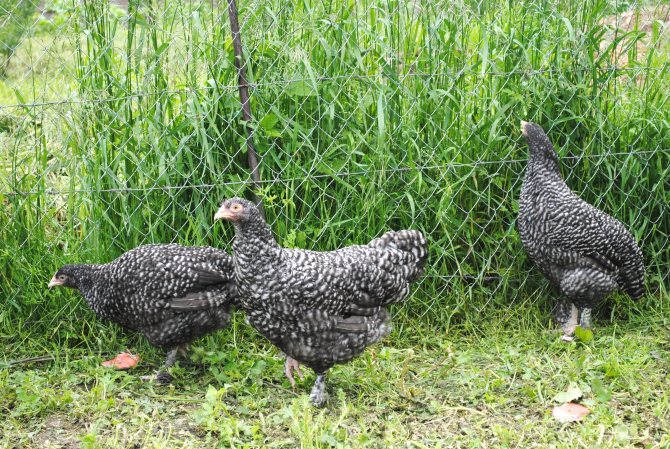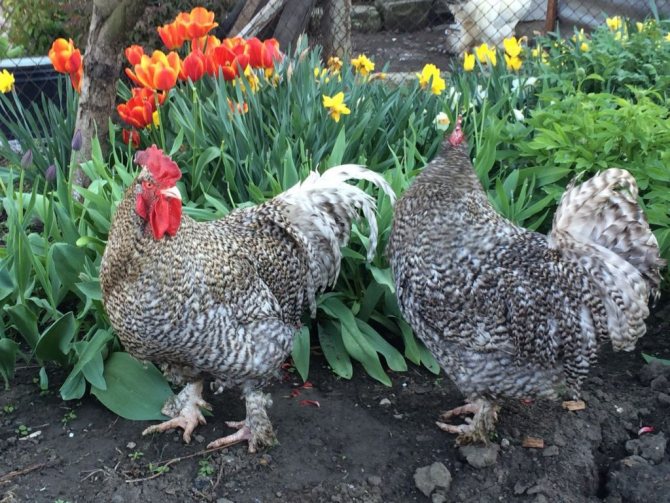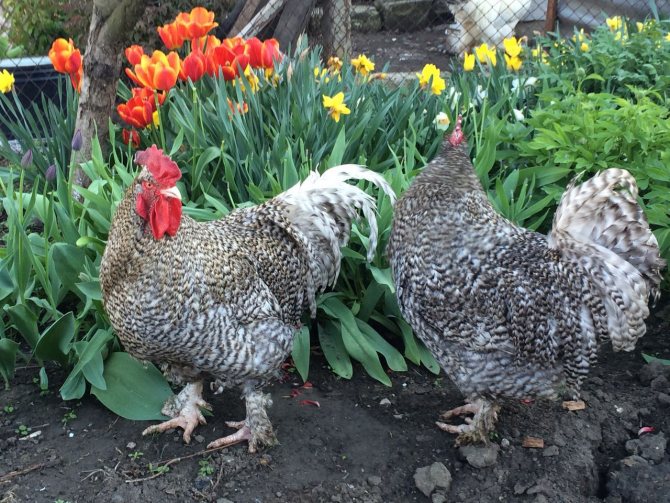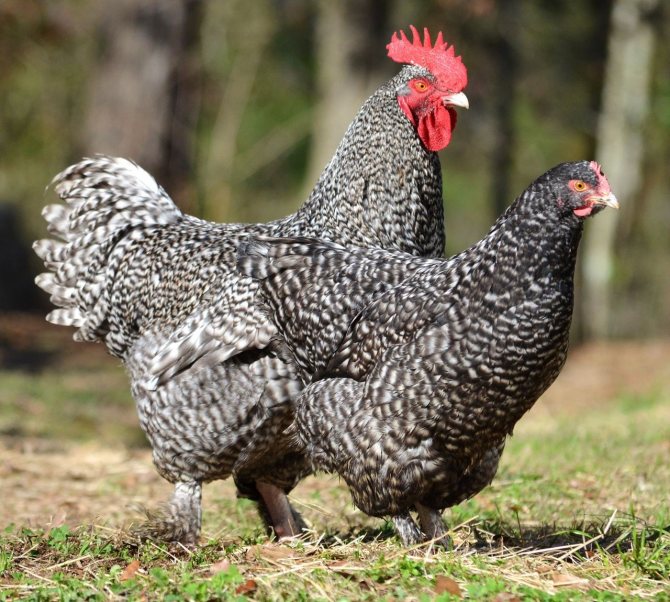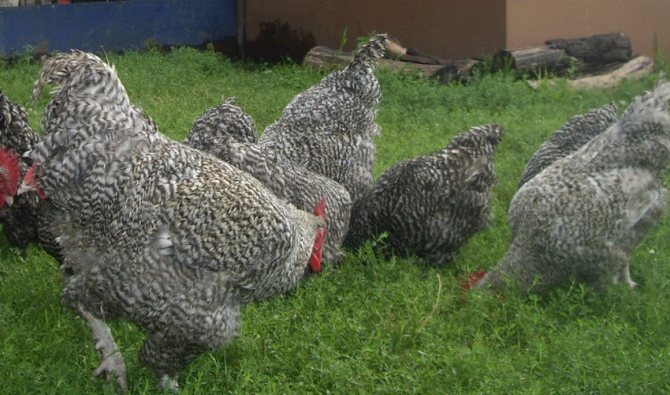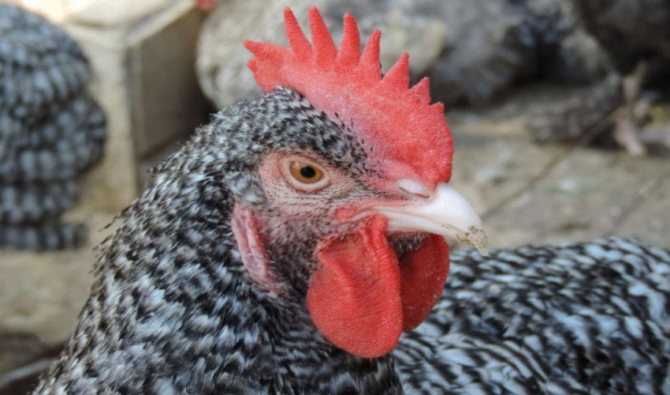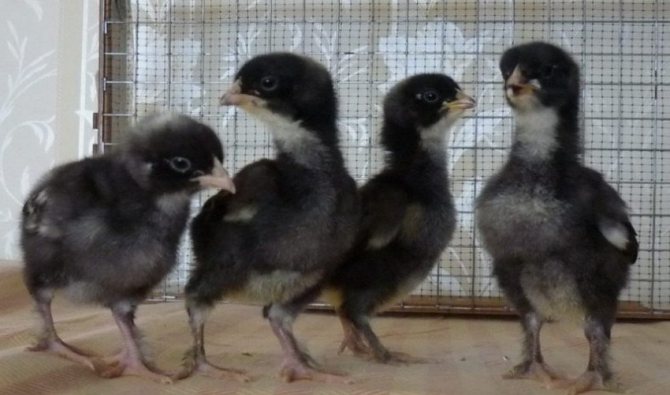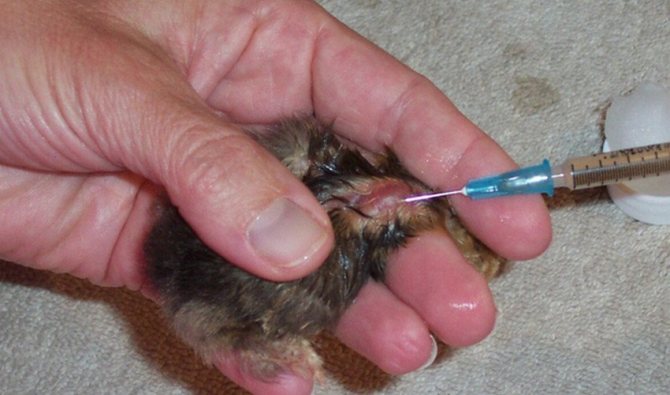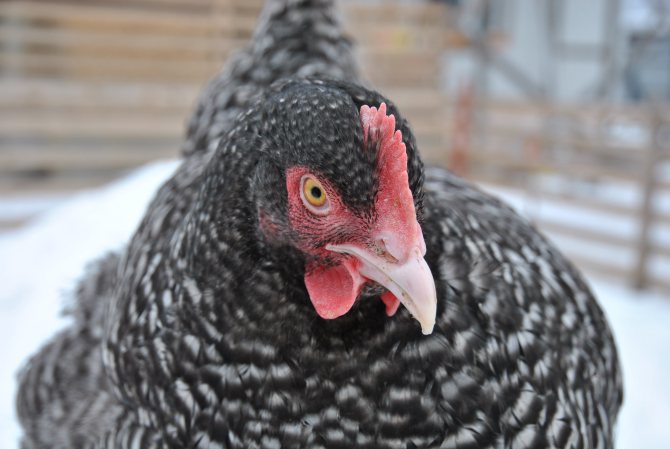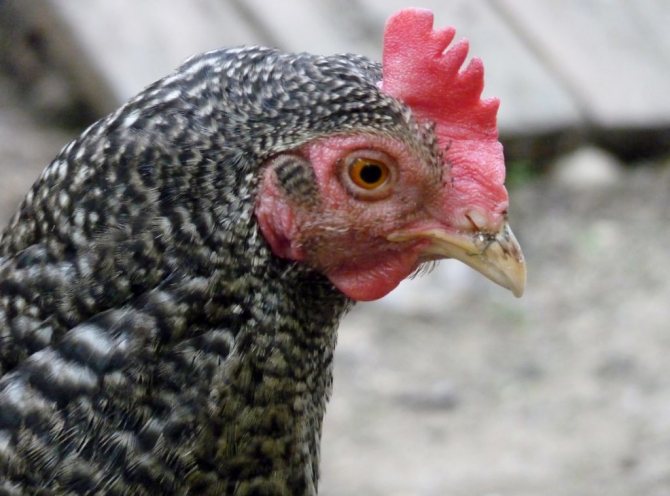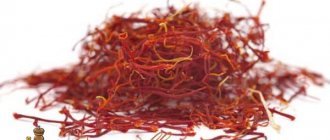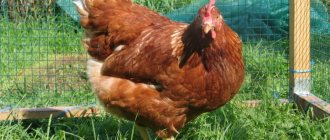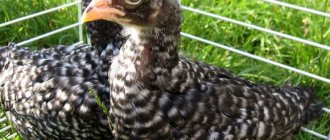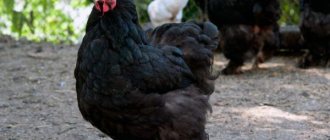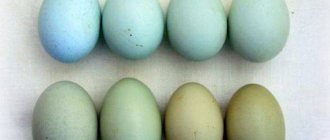Poultry »Chickens
0
1176
Article rating
The Mechelen cuckoo is known to poultry farmers by several similar names: it is called Meklin, Mechelen and Mecheln. Malin is also a common name. Mechelen meat chicken was bred in the 19th century, and in 1979 a club of fans of the breed was created. To create the chicken, they crossed the Shanghai breed and the Brahma, adding a share of the genetic material of the Flanders and Mechel cuckoo breeds.
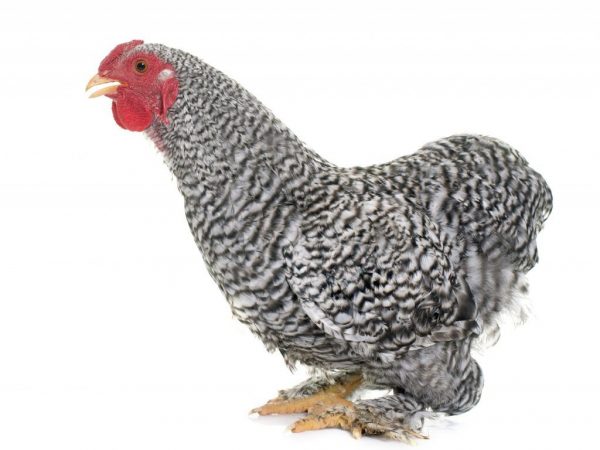
Mechelen cuckoo
The bird is of Belgian origin, it was named after the city of Mechelen. Several variations of the name of the cuckoo breed can be attributed to the constant and repeated changes in the name of the city.
History of the breed
In Russia, they learned about this breed of chickens about 100 years ago. However, it was produced much earlier, in Mechelen, which is located in Belgium. For the first time this breed was bred back in the nineteenth century thanks to the crossing of Flemish, Shanghai, Chinese hawks, as well as Flanders cuckoo chickens. Thanks to the painstaking work of scientists, a chicken was bred that satisfies the needs of most farmers to this day.
Interesting fact! Often Mechelen cuckoos are called Mecheln, Malin, Meklin. They are all the same breed. This is due to the fact that the place of origin of this type of chickens - the city of Mechelen - has repeatedly changed its name, which sounded differently in each language.
The Mechelen cuckoo is especially prized in Belgium, where in 1979 a special club dedicated to the breed was created by connoisseurs of this species. Most often, the bird is bred in small private farms, but there are also poultry farms that raise cuckoos on a much larger scale.


Appearance
The body size of this type of chicken is quite large relative to other meat breeds. Their size is comparable to such giants as Hungarian and Jersey chickens. Due to the large, well-formed bones, large breast, powerful belly and broad back, the weight of this species of roosters varies in the region of 4–5 kilograms, and of hens - 3.5–4 kilograms.


Despite the rather plump appearance, the Mechelen cuckoo is extremely obese, having a thin layer of fat with a predominant percentage of meat.
Most people often have a question about why this chicken was nicknamed the cuckoo? It's all about the plumage. Its color is very similar to that of a cuckoo. Its plumage is very fluffy and dense, and the feathers themselves are tightly attached to each other. This species also has a relatively small neck, and a small head with a pink beak. The scallop is leaf-shaped and has 4–6 teeth. The cuckoo's tail is short and small. Red skin is hidden under the plumage, and the head is covered with gray bristles. The size of the cuckoo's eyes is average.
On a note! Inexperienced farmers often confuse the Mechelen cuckoo with the Amrox chicken. Indeed, their appearance is quite similar in the description. Amroks differs only in the absence of feathering on its feet and in much smaller size (1.5–2 times).
In nature, there is a dwarf species of the Mechelen cuckoo, but it is difficult to find even a photo and video material in which it will be present, since it is very rare.


Character
The Mechelen cuckoo also takes advantage of this component. Aggression in these birds is extremely rare, most often when roosters protect chickens from attacks by other birds, animals or people. Chickens almost always quickly remember their owner and make contact with him without any problems. If you need to add another type of chickens to the Mechelen cuckoo house, this can be done without fear, since in such cases they behave friendly.
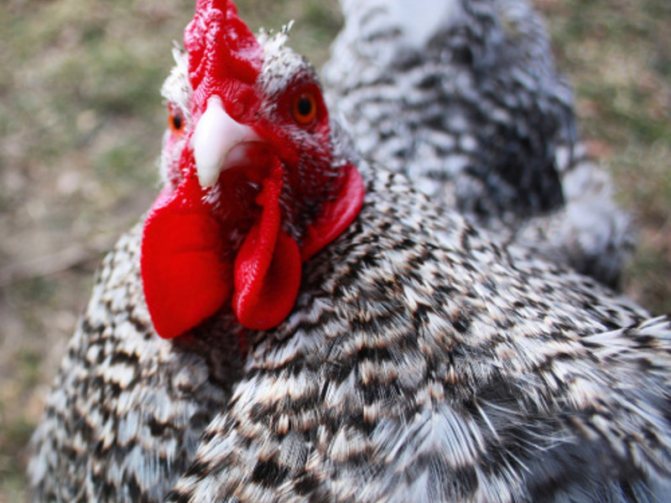

Testimonials
Larisa Lapko, Shubniki
I bought eggs directly in Belgium, transported them through Lithuania, it's easier for us. I agreed with the breeder, came, looked at his chickens, took the eggs and left. There is only one problem with Raspberries: inbreeding. Therefore, several times I went to the breeders in Belgium to take an unrelated egg. They are very sensitive to their breed and they really are very expensive in the form of carcasses. Of course, you can't sell it like that here, but for my own use I now only cut Mechelen roosters. And the rest of the breeds are all for sale.
Svetlana Melnikova, s. Prigorodnoye
Cuckoos are really very calm unhurried chickens. Not many eggs are laid, of course, but they did not expect much of them. But I really like the color. Brown is already familiar and not interesting, but here it is pink. But the main thing for the Mehlensky is meat. Very tasty and tender, even in relatively adult birds. It is believed that if an animal lives on a walk, then its meat is rougher than that of the one in the cage. These "free-range" chicken is more tender than the broilers, which we raised in cages.
Productivity
As noted a little earlier, the body weight of this species often reaches five kilograms, and when kept in favorable conditions, this figure can increase. The meat of young individuals is of the greatest value; therefore, it is recommended to slaughter them at 8–10 months of age. With age, their meat becomes tougher and worse in taste, but it can still be consumed after prolonged heat treatment.
Compared to other meat breeds, the Mechelen cuckoo rushes very often... On average, one hen lays about 140-170 eggs per year, and their weight is 60-65 grams. The puberty of a chicken begins from six months, so it begins to lay at about this age. At first, the hen lays eggs of a small size, but it will gradually increase with each new clutch. Mecklin has a very good survival rate. About 95% of the hatched chicks survive.
How to properly keep chickens
The quality and size of the room is primarily influenced by the size and characteristics of the breed. In order for Malin chickens to feel comfortable, it is necessary to provide them with the necessary conditions, including:
- Spacious, classic floor space with a low hedge (about a meter). Due to its large size, the Mechelen raspberry cuckoo cannot fly, therefore, the main funds must be allocated for a wide area of the poultry house;
- Low temperature content (about 15 ° C).
- Dry and clean area, free from drafts and winds.
- Lighting not exceeding 10-12 hours.
As for chickens, the placement of chicken eggs in the incubator takes place for a month, and before nibbling, each egg is shone through in order to reveal dead embryos or unfertilized biomaterials. After birth, chicks are placed in wooden boxes or cardboard boxes with a paper-lined bottom. The floor is covered with straw, sawdust and peat.
When hatching eggs from a Mechelen chicken, there are no difficulties. But do not forget that incubating cuckoos can only cause disappointment, because the breed's maternal instinct is completely absent, therefore hatching with the help of an incubator or other laying hen is considered the most acceptable option.
The Mechelen breed “betrays itself” from infancy: chickens survive in any conditions and have a special sex characteristic.Chickens are distinguished by a light speck on the head and a black back, while males are distinguished by a spot on the back. In the chicken coop, all individuals behave extremely calmly, therefore they never cause problems when kept with other breeds. However, one rooster considers himself to be the guardian of the entire herd, therefore it is better to keep him away from other males. You can preview what the behavior and appearance of chickens are in the video.
Maintenance and care
The Mechelen cuckoo does not require any special conditions of detention, nevertheless, it is worth adhering to simple recommendations, which will be described below.
Feeding
Health, high productivity of chickens and fast weight gain are directly dependent on good nutrition. It must be balanced and varied, whatever the purpose of the poultry. Mecklin chickens are not very demanding on nutrition. For them, the usual diet, which is fed to meat chickens, is suitable. Let's consider it in more detail:
- The bird consumes at least 100-150 grams of feed per day, depending on age and weight. Accordingly, you need to feed the bird three times a day, 30-50 grams of feed per individual.
- The main component of the cuckoo's diet is squirrel.
- When buying ready-made compound feed, mixtures for broiler chickens are perfect.
- Wet mash is also good for feed.
- Vitamins and mineral supplements should always be added to the feed.
- In the warm season, chickens usually find themselves the necessary greens for themselves while walking. In winter, they do not have such an opportunity, so it is best to prepare everything in advance for feeding during a cold snap.
- Meat and offal are also suitable for Mecklin feed, exclusively in raw form. If you serve meat cooked or fried to a bird, it may develop digestive problems.
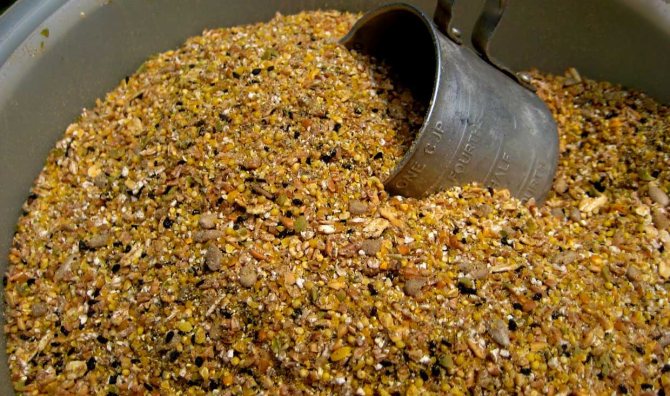

Coop and walk
As the adult grows to a large size, the house should be fairly spacious. It is not recommended to keep cuckoos in a cage. Due to its heavy weight, the bird cannot take off on perches and lives exclusively on the floor. In view of this, the bird may fall, trying to climb even a not very high perch. Based on the fact that the bird lives on the floor, careful maintenance of the flooring is necessary. It should be changed much more often than with other types of poultry. It is best to replace the flooring every week. For the embankment, sawdust, hay, straw and peat of a fairly dense layer will do. Nests should be built at floor level so that laying chickens can climb in without effort.


Birds of the Mecklin breed are agile and unhurried, but they love to walk very much. Walking helps to build muscle mass, which is good for the taste of meat. Poultry is best kept free-range; a large aviary is also suitable for walking the Mechelen cuckoo. Due to the peculiarity of the structure of the wings, as well as the large weight, the bird will not be able to take off, so the height of the fence of 120 centimeters will be quite enough. If you wish, you can release them for free range, since this type of chickens does not like to hide in secluded places, run away or spoil the crop. Belgian farmers almost always let Mecklin go for a walk in the field.
The Mechelen cuckoo is also unpretentious for good lighting. As you know, long daylight hours contribute to better egg production, and Meklin belongs to meat breeds of poultry. If chickens of meat and egg breeds need 17 hours of daylight hours, then the Mechelen cuckoo can cost 12 hours. Based on this, if only Mecklin chickens are kept in the aviary, then additional lighting is not required in winter.


The Mechelen cuckoo is also unpretentious to the air temperature. The only condition that should be adhered to is to prevent the temperature in the chicken coop from falling below 12 degrees. In a temperature regime of 12-14 degrees, this bird feels quite comfortable. The minimum temperature at which a Belgian chicken can stay in a chicken coop must be at least 4 degrees. However, prolonged exposure of Mecklin at this temperature is not recommended, as this can negatively affect egg production.
It is best if the chicken coop is equipped with exhaust ventilation, but if absolutely necessary, you can do with a regular window. At the same time, drafts in the chicken coop are unacceptable, because this can negatively affect the health of the birds.
In the chicken coop, moisture also needs to be controlled. With increased moisture, bacteria multiply very quickly and lead to poultry diseases.
Breeding and caring for chickens
For beginners, breeding this species of bird may seem like a very troublesome task. The reason is that, like most hybrids, the Mechelen cuckoo has virtually no maternal instinct.... Based on this, there are two ways to breed this breed of chickens: by incubation and laying Mecklin's eggs to other breeds of chickens.
For successful incubation of Mechelen cuckoo eggs, you must adhere to the following rules:
- select only high-quality eggs for the process, chips and cracks will cause moisture loss from the egg and stop the development of the embryo;
- before laying eggs in the apparatus in which they are turned over manually, it is necessary to make notes at the bottom and top of the egg so as not to miss one of them during the next turning;
- carefully monitor temperature and humidity, since these factors are paramount for the development of the fetus.
On a note! Periodic ovoscopy will help to discard bad eggs in a timely manner in order to obtain healthy offspring.


For those who do not want to face the incubation process, you can buy both two-week-old chicks and an adult. The approximate price for chickens will be 400 rubles, and an adult chicken will cost 3000.
Chickens of the Mecklin breed hatch very small. Their weight is only 42–45 grams. Their genus can be easily distinguished by color, since females' down is darker, and a characteristic white spot flaunts on the crown. Chickens of this breed are unpretentious in terms of keeping conditions, so they can be left in the same enclosure with the rest of the young. For the successful rearing of chickens, you need to follow some nutritional recommendations:
- Newborn chicks require seven meals a day. One month after birth, the number of meals is reduced to four times. After puberty, the bird will need to eat 3 times a day.
- For fast growth of chicks, more protein food is required.
- Fresh herbs and vegetables should make up at least 35% of the chicks' diet. It should be varied, and it is advisable to include carrots, pumpkin, potatoes, clover, green onions in the feed.
- Mineral additives must be present in pullet feed. First of all, it is worth remembering the addition of shell rock and chalk.
In general, there should be no problems when growing Mechelen cuckoos, since they have good immunity and unpretentiousness to content. Difficulties can arise only in case of neglect of the basic rules for keeping birds, as well as a sick animal joining them.
Pedigree features
Feather coloring page
The description of the Mechelen cuckoo includes characteristic features.
The common color of chickens of this breed is cuckoo. He's pockmarked, motley, speckled. Each feather on the body of a Meheln chicken is colored gray-white.
The breed standard provides for other colors: white, black, pearl, blue. But they are much less common. More about this can be found in the article "About Raspberry Chickens."
Exterior
Chickens of the Mechelen cuckoo breed have a dense body build. They are stocky, well-fed and therefore heavy to lift.
The wings of birds are short, tight to the body.
The eyes are red with an orange sheen.
The crest is leaf-shaped, dense and fleshy, of medium size. Consists of 5-6 teeth, colored red. Less common is the pod-shaped scallop.
Small but strong beak with a whitish tint.
Earrings and lobes are oblong, medium size, fiery red.
Mechelen cuckoos have short tails, even roosters.
The legs are strong. The inside is bare, and the outside is densely covered with feathers. A sign of decorative chickens.
The plumage is dense and dense.


Sexual characteristics
Chickens are slightly darker than roosters. There is a white spot on the top of the head.
Males have a dark head. And the light spot is located on the back.
Roosters can also be distinguished by their broad, rounded sternum.
Disqualifying flaws
Mechelen cuckoos should be discarded if the following deviations from the standard are observed:
- too light colors;
- narrow skeleton;
- flat chest;
- white lobes;
- too high legs;
- triangular body shape.
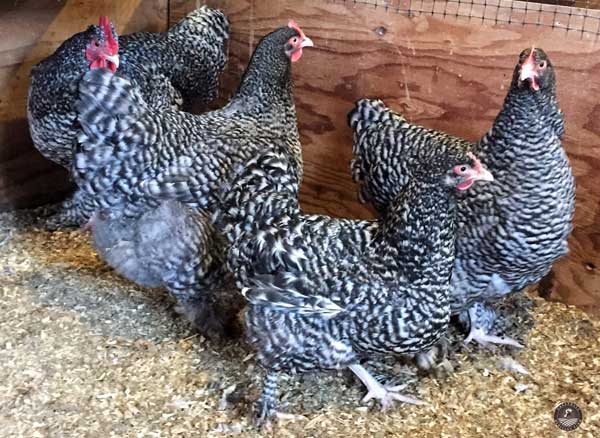

Temperament
Representatives of this breed of chickens are calm and balanced. They get along with all the inhabitants of the poultry yard, as they are friendly and restrained.
Roosters rarely show aggression. Although in case of danger, this is not excluded.
Pros and cons of the breed
It should be noted in advance that this breed of birds has much more advantages over other breeds. Of these, we can distinguish:
- large carcass weight (4–5 kg), which is important for poultry for meat purposes;
- unpretentiousness to conditions of detention, as well as strong immunity;
- although cuckoos are not classified as egg-laying chickens, their eggs are quite large - 55-60 grams;
- calm nature, predisposed to living peacefully with other types of chickens;
- good fertility, as well as a high survival rate of chicks.


Along with all the above advantages, this breed of bird has only one significant drawback - the lack of maternal instinct, therefore, an incubator is required for breeding it. Some sources claim that Mecklin was called a cuckoo for this very reason, but this information has not been confirmed.
It can be concluded that growing the Mechelen cuckoo chicken breed is not only very simple, but also profitable. Experienced farmers have repeatedly confirmed this information in their reviews, advising this particular species to both beginners and experienced breeders.
disadvantages
- Difficulties in breeding.
- Fading instinct for incubation.
This, in principle, is all there is to know about the feathered giantess Belgian. Help your friends also get to know this type of Raspberry breed of chickens - share the link on social networks. Don't miss out on new items - by subscribing to site updates, you will be the first to read the latest publications!
All the best to you and see you soon!
In the comments you can add your photos of laying hens, rooster and chickens! Or other poultry. We're wondering what kind of chicken coop you have? Did you like the article? Share with your friends on social networks:

